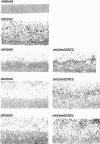Virulence of the fungal pathogen Candida albicans requires the five isoforms of protein mannosyltransferases
- PMID: 16040968
- PMCID: PMC1201229
- DOI: 10.1128/IAI.73.8.4571-4580.2005
Virulence of the fungal pathogen Candida albicans requires the five isoforms of protein mannosyltransferases
Abstract
The PMT gene family in Candida albicans encodes five isoforms of protein mannosyltransferases (Pmt proteins Pmt1p, Pmt2p, Pmt4p, Pmt5p, and Pmt6p) that initiate O mannosylation of secretory proteins. We compared virulence characteristics of pmt mutants in two complex, three-dimensional models of localized candidiasis, using reconstituted human epithelium (RHE) and engineered human oral mucosa (EHOM); in addition, mutants were tested in a mouse model of hematogenously disseminated candidiasis (HDC). All pmt mutants showed attenuated virulence in the HDC model and at least one model of localized candidiasis. The pmt5 mutant, which lacks in vitro growth phenotypes, was less virulent in the EHOM and HDC assays but had no consistent phenotype in the RHE assay. In contrast, the pmt4 and pmt6 mutants were less virulent in the RHE and HDC assays but not in the EHOM assay. The results stress the contribution of all Pmt isoforms to the virulence of C. albicans and suggest that the importance of individual Pmt isoforms may differ in specific host niches. We propose that Pmt proteins may be suitable targets for future novel classes of antifungal agents.
Figures



References
-
- Aoki, S., S. Ito-Kuwa, K. Nakamura, K. Ninomiya, and V. Vidotto. 1994. Extracellular proteolytic activity of Cryptococcus neoformans. Mycopathologia 128:143-150. - PubMed
Publication types
MeSH terms
Substances
LinkOut - more resources
Full Text Sources
Other Literature Sources

